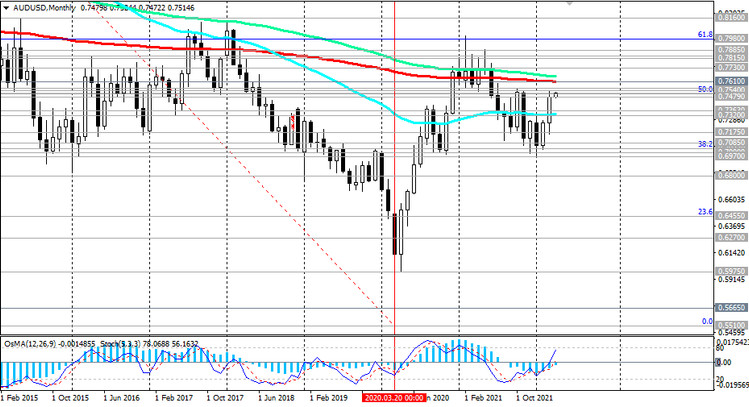Despite the strengthening of commodity currencies against the US dollar, the DXY dollar index is growing again today, mainly due to the continued weakening of the euro (the share of the euro in the DXY dollar index, which evaluates the value of the dollar against a basket of 6 major currencies, is approximately 58%) against it. The EUR/USD pair is falling today for the 3rd day in a row, and as we can see, the DXY dollar index is also rising today for the 3rd day in a row.
Although the data from the US labor market, published last Friday, turned out to be ambiguous, they nevertheless confirmed the likelihood that the Fed will decide to raise the interest rate at the next meeting (May 3-4) by 50 basis points at once.
The unemployment rate fell to 3.6% in March from 3.8% in February, while average hourly earnings in the US rose significantly (+5.6% in annual terms), the US Department of Labor said last Friday. Unemployment fell and hourly earnings rose more than economists had expected. However, the NFP came in below the +490,000 job growth forecast, coming out at +431,000. The relative decline in this figure likely kept the dollar from strengthening more strongly. The US March jobs report, despite a weaker NFP, still paints a picture of a healthy labor market and justifies further tightening of monetary policy.
Meanwhile, as we noted at the beginning of our review, the main commodity currencies (Canadian, New Zealand, Australian dollars) maintain positive dynamics against the background of rising energy prices and other commodities.
As recently reported by Stats NZ, world imports of petroleum products increased in value by 81% in January and February, imports of fertilizers rose by 161% in prices. It is obvious that the negative dynamics of the indicators is caused both by the growing rates of global inflation and by interruptions in the supply of energy resources to the world market and their sharp rise in prices.
In particular, one of the shocks for the world economy, especially the European one, was the military conflict in Ukraine, where Russia is conducting a military special operation. Economists are already predicting a recession in the Eurozone if European consumers stop importing Russian energy to Europe.
Canada, New Zealand, Australia are the largest suppliers of agricultural products and commodities to the world market, and rising prices for them contribute to the strengthening of the currencies of these countries, including against the US dollar.
Thus, the AUD/USD pair has grown over the past 2 months by 3.1%, having risen to current levels near the resistance level 0.7510.
Today, AUD/USD is also growing, while the Australian dollar received additional support from positive macro data published last Thursday, Friday, according to which the PMI activity index in the manufacturing sector from Commonwealth Bank rose in March to 57.7 from 57.3 in February, outperforming the same forecast of 57.3, the Reserve Bank of Australia Commodity Price Index rose 40.9% in March, well above the expected 10% rise and the previous 34%. TD Securities' inflation figures released this morning were also higher than expected. Thus, calculated by the Melbourne Institute, the inflation indicator in March rose by 0.8% compared to February. In annual terms, the indicator rose by 4.0% against 3.5% in February. The data points to accelerating inflation and increases the likelihood that the Reserve Bank of Australia will revise upward its February inflation forecasts.
Economists say the fiscal year 2022-2023 budget released last week will support the economy with stimulus spending and employment growth will continue.
According to ANZ, the number of employees increased by 0.4% in March, and the number of job postings was 57.5% higher than the pre-Covid level. The Australian Bureau of Statistics (ABS) job vacancy indicator is holding near record highs, and economists expect the unemployment rate to fall to a record low of around 3% (from 4% currently).
It is clear that the Australian economy is strengthening and the demand for labor is growing.
Tomorrow there will be a regular meeting of the RBA dedicated to the issues of monetary policy. It is expected that at this meeting, the Central Bank of Australia will leave the interest rate at the current level of 0.1%, although unexpected decisions are not ruled out, given the improvement in the country's labor market and the accelerating rise in prices for raw materials (Australia's main export commodity), spurring inflation.
In an accompanying statement, RBA officials will explain the reasons behind the rate decision. If the RBA signals the possibility of tightening monetary policy in the near future, then the Australian dollar will receive an additional incentive for further strengthening, and a breakdown of the local resistance level 0.7540 will push the AUD/USD pair to further growth with the current target at 0.7610. A breakdown of this resistance level and further growth can finally bring AUD/USD into the zone of a long-term bull market.






